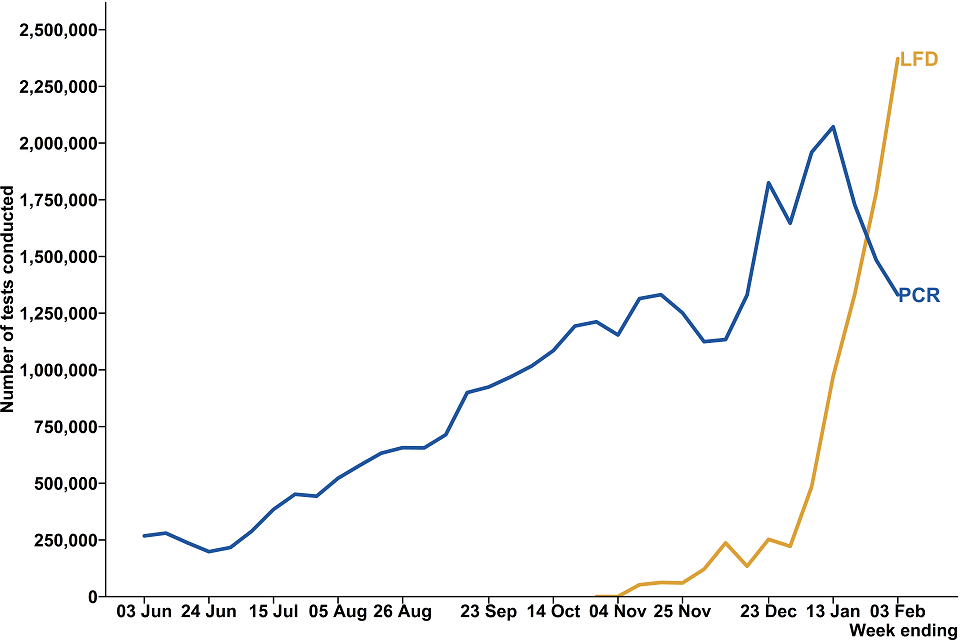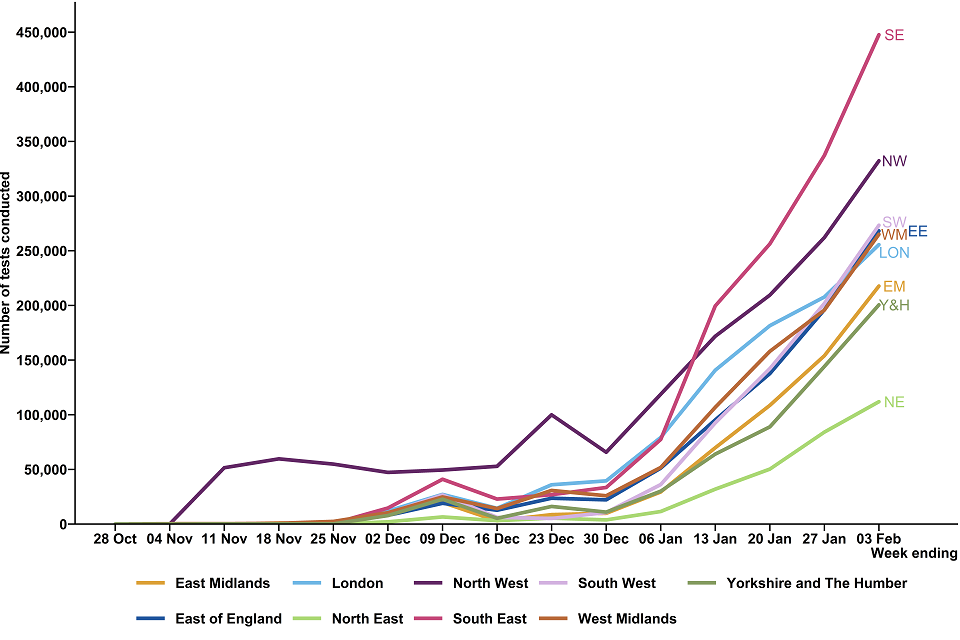Weekly statistics for rapid asymptomatic testing: 28 January to 3 February 2021
Published 11 February 2021
Applies to England
Introduction
This statistical publication aims to provide information on rapid testing for people without COVID-19 symptoms in England. This includes:
-
the number of LFD tests conducted in England by test result
-
the number of LFD tests conducted in England by region
This publication focuses on rapid testing using lateral flow device (LFD) tests, however polymerase chain reaction (PCR) tests are included where appropriate for comparison. All data used in the report can be found in the ‘Tests conducted: 28 May 2020 to 3 February 2021’ data tables on the weekly publication page.
This includes information on both LFD and PCR tests at lower tier local authority level and reports on the number of tests conducted and not the number of people tested. Individuals can be tested more than once, for more information please see information for users.
The figures in this report include LFD tests which were registered through the National Testing Programme digital infrastructure. They do not currently include LFD tests conducted where the tests were not registered via this route. LFD tests for the majority of secondary care NHS staff and some testing within the private sector testing are therefore not included. See the About this data section below for more information.
Background
Types of tests
PCR tests
PCR tests check for the genetic material of the coronavirus in the sample, which is taken using a swab and is processed in a lab via a polymerase chain reaction (PCR). This type of test is predominantly used for anyone who has symptoms, or to confirm a positive LFD test result in certain use cases, including:
-
self-reporting LFDs[footnote 1]
-
cross channel hauliers
LFD tests
LFD tests, often referred to as rapid tests, test for the presence of proteins called ‘antigens’ which are produced by the virus. They are swab tests that give results in 30 minutes or less, without the need for processing in a laboratory. These tests are primarily used for those who do not have symptoms.
From 21 October 2020, LFD tests were made available in limited capacity except where rapid testing pilots were conducted. Since then, their availability has expanded to a broader range of settings.
Rapid testing for people without symptoms
Rapid testing using LFD tests is currently being offered to people who do not have symptoms, in a range of different settings.
Some LFD testing is carried out at asymptomatic test sites, which are deployed in a range of community settings such as universities, schools, care homes and workplaces. They are also set up by local authorities as part of the community testing program. Testing at these sites is assisted: a person will take a swab test under the supervision of a trained operator who then processes the test then reads and records the result.
Some LFD testing is carried out entirely by individuals themselves (that is an individual takes their own test, unassisted, and reports their own result), however in these specific situations (see the Types of tests section above) if a positive test result is returned the individual is required to take a confirmatory PCR test. For more information see understanding lateral flow tests for people without symptoms.
LFD tests conducted, England[footnote 2]
The number of LFD tests conducted has been increasing overall since their introduction in October 2020. In the latest week (28 January to 3 February), 2,372,358 LFD tests were conducted, which is over 17 times higher than mid-December.
In comparison, in the latest week 1,330,889 PCR tests were conducted. In the latest week, more LFD tests were conducted than PCR tests, the first time since LFDs were made available. This reflects the increasing use of LFD tests, as well as a decrease in symptomatic people taking a PCR test.
PCR and LFD tests have different uses and are therefore applied in different situations (see the Types of tests section above for more information). The primary purpose of rapid LFD testing is to identify people with COVID-19 who do not have symptoms. As the number of LFD tests conducted increases, more asymptomatic positive cases are identified earlier and therefore they are less likely to transmit the virus to their contacts.
Of the LFD tests conducted in the latest week, 9,480 tests returned a positive result and 2,359,422 tests returned a negative result. Since LFD tests were introduced, 73,793 positive results and 7,999,053 negative results have been reported.
Figure 1: number of LFD and PCR tests conducted, England

This data can be found in the ‘table_1’ and ‘table_2’ tabs of the ‘Tests conducted: 28 May 2020 to 3 February 2021 data tables’ on the weekly publication page.
LFD tests conducted by region, England
The number of LFD tests conducted has been increasing overall across all regions for the past month. Between 27 January and 3 February 2021, the most LFD tests were conducted in South East followed by North West.
Figure 2: LFD tests conducted by region, England[footnote 3]

This data can be found in the ‘table_4’ tab of the ‘Tests conducted: 28 May 2020 to 3 February 2021 data tables’ on the weekly publication page.
About this data
Lateral flow device tests were first made available from 21 October 2020 in England. This data contains LFD tests reported through the existing National Testing Programme digital infrastructure and does not include LFD tests conducted where the tests were not registered via this route that is used to collect data for this report.
The following use cases for LFD tests are not currently reporting results digitally into Test and Trace systems, and therefore are excluded from this report:
-
testing for the majority of NHS secondary care staff
-
testing for some staff in private sector industries
In these cases, test results should be reported directly into Public Health England. In future, all LFD tests will be reported via the existing National Testing Programme digital infrastructure and will be included.
A full explanation of the data sources and methods used to produce these statistics can be found in the NHS Test and Trace statistics methodology.
Data quality
Given the importance of this service and the commitment of NHS Test and Trace to be open and transparent with the public it serves, this data is being released at the earliest possible opportunity. However, this data should be treated with caution whilst the understanding of the data and its quality improves.
The requirement for care home staff to register negative LFD test results was suspended between 31 December 2020 and 15 January 2021 inclusive, following a change in guidance issued on 23 December 2020 to increase testing in care home staff. As a result, a proportion of LFD tests conducted on care home staff will not be included for these dates.
An LFD test produces a result on the device almost immediately, without it being automatically recorded, therefore some results might not be captured. For settings where self-reporting LFD testing procedures[footnote 4] are in place, it is likely that the number of tests conducted are underreported. It is however their statutory duty to do so, and easier reporting tools are being rolled out to support these individuals to report their tests as quickly and efficiently as possible. It is possible that tests with a negative result are more likely to be affected, therefore it is not advisable to calculate a positivity rate with the data.
More information on data limitations and how the figures in this publication can and can’t be used is outlined in the NHS Test and Trace statistics methodology.
Future developments
We continue to explore the feasibility of adding new breakdowns to the publication on rapid testing to support user needs. Over the coming months, we intend to make data available on the following:
-
rapid testing for asymptomatic NHS staff
-
rapid testing in schools, higher education and universities
-
rapid testing in public and private industries
-
community testing programme
For feedback and any further questions, please contact [email protected].
-
Self-reported results from LFDs are where the individual carrying out the test on themselves is expected to report their own test and subsequent result. ↩
-
Counts of LFD tests conducted do not include tests which weren’t reported through the National Testing Program digital infrastructure. ↩
-
Absolute number of tests conducted in each region and does not take into consideration population of regions. ↩
-
Self-reporting LFDs are where the individual carrying out the test on themselves is expected to report their own test and subsequent result. ↩
